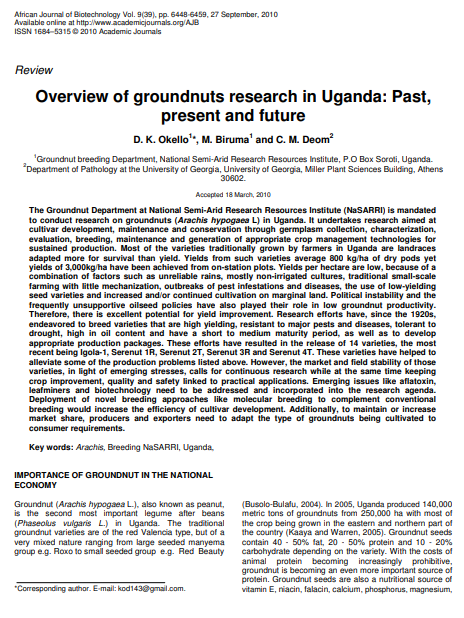Overview of groundnut research in Uganda: past, present and future
Summary
The Groundnut Department at the National Semi-Arid Research Resources Institute (NaSARRI) is mandated to conduct research on groundnuts (Arachis hypogaea L.) in Uganda. It undertakes research aimed at cultivar development, maintenance, and conservation through germplasm collection, characterization, evaluation, breeding, maintenance, and generation of appropriate crop management technologies for sustained production. Most of the varieties traditionally grown by farmers in Uganda are landraces adapted more for survival than yield. Yields from such varieties average 800 kg/ha of dry pods, yet yields of 3,000kg/ha have been achieved from on-station plots. Yields per hectare are low because of a combination of factors such as unreliable rains, mostly non-irrigated cultures, traditional small-scale farming with little mechanization, outbreaks of pest infestations and diseases, the use of low-yielding seed varieties, and increased and/or continued cultivation on marginal land. Political instability and frequently unsupportive oilseed policies have also played their role in low groundnut productivity. Therefore, there is excellent potential for yield improvement. Research efforts have, since the 1920s, endeavored to breed varieties that are high yielding, resistant to major pests and diseases, tolerant to drought, high in oil content and have a short to medium maturity period, as well as to develop appropriate production packages. These efforts have resulted in the release of 14 varieties, the most recent being Igola-1, Serenut 1R, Serenut 2T, Serenut 3R, and Serenut 4T. These varieties have helped to alleviate some of the production problems listed above. However, the market and field stability of those varieties, in light of emerging stresses, calls for continuous research while at the same time keeping crop improvement, quality, and safety linked to practical applications. Emerging issues like aflatoxin, leaf miners, and biotechnology need to be addressed and incorporated into the research agenda. Deployment of novel breeding approaches like molecular breeding to complement conventional breeding would increase the efficiency of cultivar development. Additionally, to maintain or increase market share, producers and exporters need to adapt the type of groundnuts being cultivated to consumer requirements.
Open resource Download resource Access resource on external site

